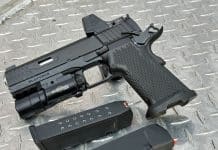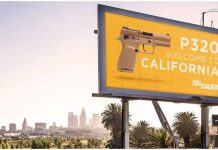Reloading is a lot like cooking. You find a recipe, try it, and either throw it out, or tweak it to your liking. When building up your first custom built piece of ammo, its the same thing.

Grab a manual, pick a load combination, see how it patterns, and either throw it out or make small changes until its just right. By taking control of your ammo, you can design and build a round that will likely shoot better in your firearm than any ammo you can buy off the shelf today.
Funny title though right? You’d think we’d want to be precise as possible. Who wants to be partially precise?
Everything has a rate of return. Often times that rate of return follows a curve, and before long, that curve takes a steep drop. Reloading your own ammo is no different. A person could take great pains to turn necks, uniform meplats, weigh every fire formed case, weigh every premium projectile, and carefully measure chambers. But here’s the deal. Eventually the hours and hours you put into many of these steps for 10 perfect rounds don’t always produce a benefit visible by every shooter. Not everyone is capable of the same accuracy as their firearm.
Also read:
Part I: Cooking Up Some Loads For The Semi-Prescision Rifle Shooter
Part II: The Equipment To Load
Part III: Loading For The Semi Precision Rifle
Part IV: Performing The Ladder Test
This series of articles isn’t meant to describe all the steps a bench rest shooter goes through to get a record .009” center to center five shot group at 100 yards with a custom bench gun that weighs as much as a boat anchor…a beautiful boat anchor. This information is written to help transform a stock varmint rifle, tactical rifle, or heavy barreled hunting rifle into a respectable shooter capable of 1/2 MOA accuracy (.5” group at 100 yards.) Action bedding, free floating, light triggers, and solid glass all help, but if you’re feeding your gun crap ammo, you’ll still get crap results.
Note that these writings are only based on my experience and the experience of those around me. None of it should be taken as absolute. There are plenty of opinions out there on the techniques of reloading, tools, and components used. This is just one opinion.
Lets start.

Picking Components
The combinations of powder, primer, case, and bullet are endless. So it all boils down to what your plans for the round and gun combination are. Currently my go to .308 round for a Remington 700 Model 5R is
- Case – Nosler Custom Reloading Brass
- Primer – CCI BR2
- Powder – 43.5 grains of Varget
- Bullet – 175 Sierra MatchKing HPBT
- Overall Length – 2.810”
This round gives consistent sub 1/2 MOA accuracy in this gun pushing 2600 FPS at the muzzle. It may not work as well in other firearms, but thats the beauty of hand loading. We’re custom making a round that your gun loves.
Any of the major brand cases will serve you well, with an advantage to Nosler and Lapua cases for their consistency. I’ve found that among other things, primers seat with very uniform pressure, and the neck wall thickness is very uniform in Nosler cases compared to Winchester and Remington. This isn’t to say you can’t get great accuracy out of once fired factory Winchester brass, its only an observation in consistency.
Powder choice will vary greatly depending on your cartridge of choice. Different powders burn at different speeds. Generally speaking, rifle powders burn rather slowly, while shotgun and pistol powders burn faster. Because of this burn rate, some powders will push a bullet faster than others with a smaller charge. For many rifle rounds, Varget is very popular, and consequently at this time its almost impossible to find. If you’re loading for .308 or .243 you might find good success with IMR 4064, or H380. The reality is, you’ll likely find consistent accuracy with most modern propellants designed for rifles. Whatever powder you choose, make sure you verify that its compatible with the round you’re using at Hogdgen Powder. Reloading isn’t difficult, but if you don’t pay attention, you can cause serious harm to your face.
I’ll be honest. With my shooting ability (I’m no Hathcock), I haven’t seen much of a difference in performance consistency by switching out primers. I’ve used Winchester, Remington, and CCI. Each one provided good results. Note that there are multiple sizes of primers though. Smaller rounds like the .223 use a small rifle primer, and larger rounds like the .308 use a large rifle primer. Figure out the other components, get a round that shoots well, then start trying different primers.
Projectiles. This is where it can get confusing. Midway USA alone lists over 1500 options for rifle projectiles, with nearly 300 for .30 caliber alone, so a clear purpose really needs to be outlined before this choice is made. Will this round ever be used for hunting? How far are you going to shoot it? How fast is the twist rate in my gun? These are important things to think about for multiple reasons.
If this round will ever be used for hunting, you need to use a projectile designed for hunting the game you’ll throw it at. Some calibers can be effective on a wide variety of game, but only with a wide variety of bullets. For instance, the .243 is a great round for medium varmints with a 55 grain Sierra BlitzKing or Hornady V-Max. But, thats not what you want to send a mule deer at 500 yards! In that case a heavier 95 grain Berger VLD can provide the power needed to produce a clean ethical kill. If the round will only be used for paper and steel, consider one of the many match grade bullets produced by Sierra, Hornady, Nosler, or Lapua. These projectiles are built with consistency in mind, not expansion or weight retention.
Its easy to assume that a lighter bullet produces higher speeds, and therefore shoots flatter. Nope. Thats not the case. Consider two options for the .308 Winchester. A 43.5 grain load of Varget will push a 168 grain MatchKing 100 FPS faster than a 175 grain MatchKing. But, at a thousand yards, the 175 actually falls less than the 168 with the same powder charge. Its not by much, but there is a difference.
Enter the ballistic coefficient. Each bullet has it, and when shooting long range, its important to consider. The ballistic coefficient of a projectile, as Wikipedia puts it, is its “ability to overcome air resistance in flight.” This is represented by a number. The BC for a Sierra 168 grain MatchKing is .462, while the 175 is .505. This increase in ballistic coefficient plays a major role in the 175’s ability to retain its velocity at longer ranges, and its ability to fight the effects of crosswinds.
Another thing to consider when picking a starting bullet weight is the twist rate in your firearm. Barrels with slower twist rates generally like a lighter bullet. For instance, a .308 barrel with a 1 in 12 twist rate could very well shoot great with 175s at 100 yards. But, what happens at 500 or 600 yards? The slower twist may not stabilize the bullet that far out, and your consistency goes right out the door when your bullet starts to fly like a wobbly football. But, a 1 in 10 twist rate can easily stabilize a 175 at that range. You can’t guarantee your gun will love a bullet, but by paying attention to the twist rate of your barrel, you can give it a good chance.
So, to wrap this installment up, find some quality brass, grab some correctly sized primers and compatible powder, then decide on a projectile to start with. None of this is set in stone, and changing your mind next week is all part of the fun. Don’t worry about the decisions too much, as long as they are compatible with your firearm. Next time around we’ll get into some of the loading equipment and brass preparation.













[…] Part I: Cooking Up Some Loads For The Semi-Prescision Rifle Shooter […]
[…] Part I: Cooking Up Some Loads For The Semi-Prescision Rifle Shooter […]
[…] July 23, 2013Cooking up some loads for the Semi-Precision rifle shooter […]
Comments are closed.